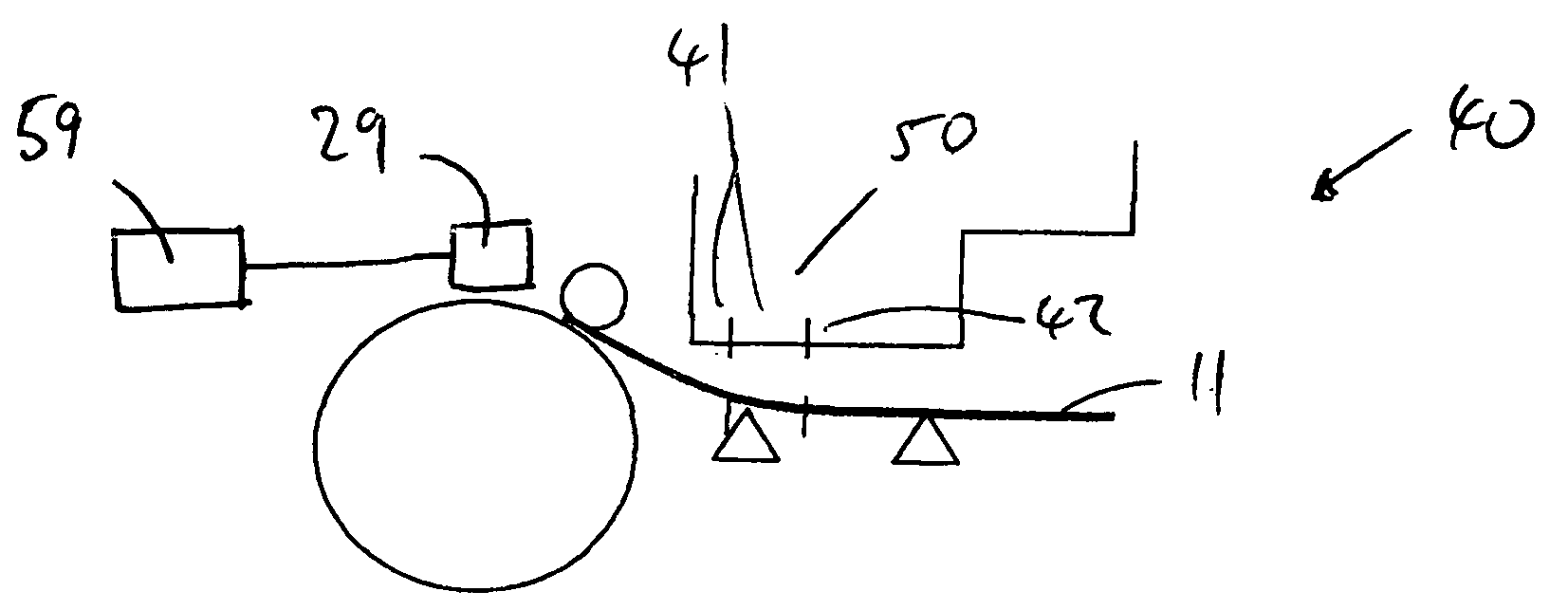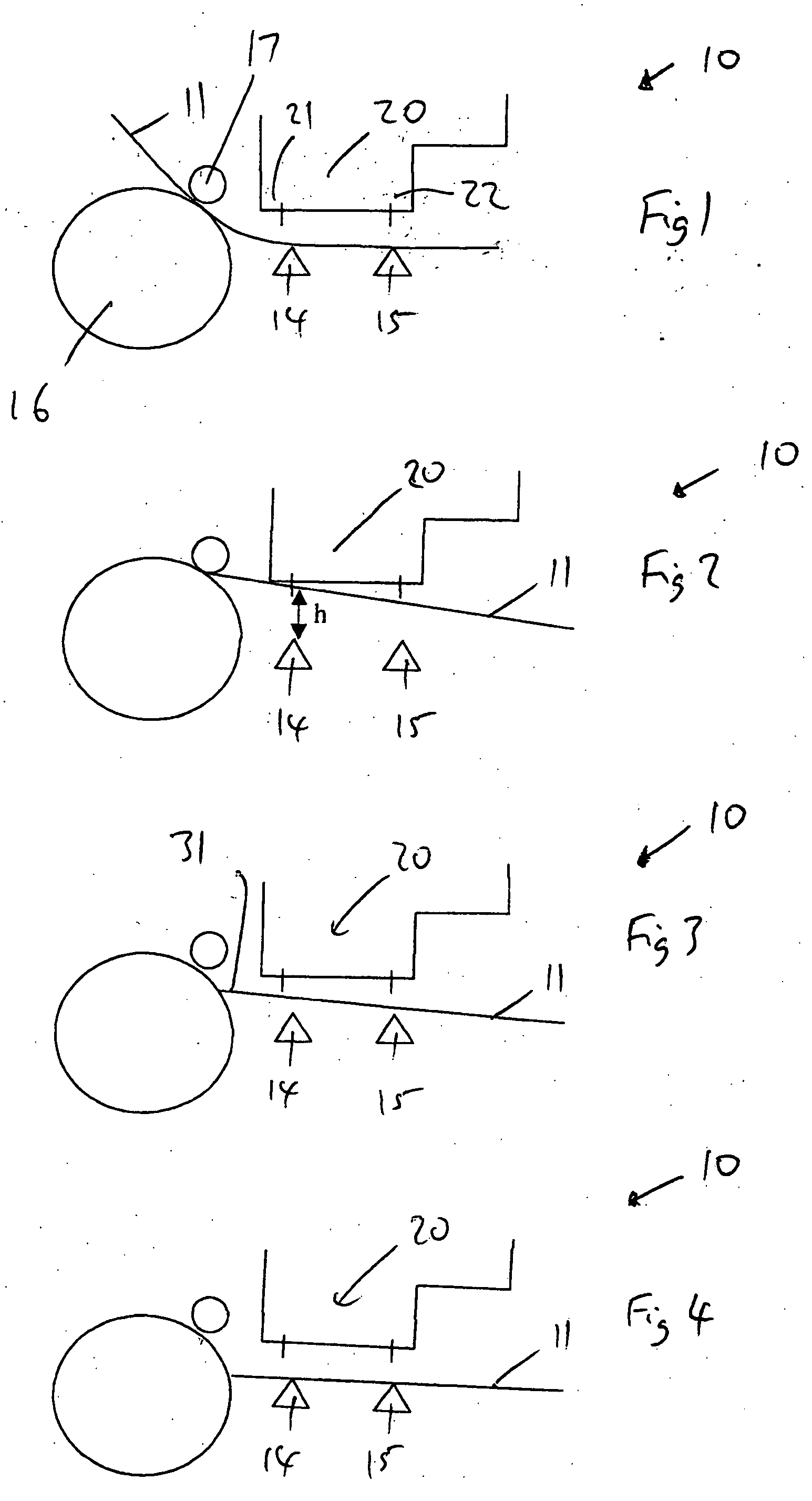Print media edge printing
a printing media and edge technology, applied in the field of printing, can solve the problems of ink collection arrangement occupying a considerable amount of space and printing is not continuous, and achieve the effect of improving the visual appearan
- Summary
- Abstract
- Description
- Claims
- Application Information
AI Technical Summary
Benefits of technology
Problems solved by technology
Method used
Image
Examples
first embodiment
[0041] Referring now to FIGS. 6 and 7, the present invention comprises a printing mechanism 40 similar to that shown in FIGS. 1 to 4. However, it will be seen from FIG. 6 that only the nozzles in the group located between lines 41 and 42 in the left-hand side of the printhead 50 are used to fire ink onto the main central region of the print media 11. In FIG. 6, the paper media 11 is just about to be released from the pinch.
[0042] The printing process is under the control of a printing controller 59. As printing proceeds down the print media, the position of the trailing edge 31 of print media 11 is monitored by a paper sensor 29 directly (e.g. optically) and / or indirectly (e.g. by summing the preceding print media advance movements). Sensor 29 is connected to controller 59. In the present embodiment, instead of continuing uniform medium advances through the positions indicated in FIGS. 2 and 3, the print media is caused to undertake a relatively long advance movement to the position...
second embodiment
[0057] the present invention, which seeks to remove or at least further reduce the remaining printing artefacts, will now be described in connection with FIGS. 10 to 13.
[0058] Typically a scanning printhead comprises 304 nozzles arranged in two lines, of which 288 nozzles are used to fire ink on to a print media. To avoid print defects, it is usually the nozzles at the ends of the lines which are not used. In the second embodiment, the main region of the print media is printed in four passes with swaths having effectively full swath height, i.e. 288 nozzles. This will be called Print Mode A. As the bottom edge region is approached the number of nozzles used to fire ink is progressively reduced. This involves two stages: firstly the modification of the printing mask so that a reduced number of nozzles is used, and secondly the print media advance is reduced. Printing in the second stage will be called Print mode B.
[0059]FIG. 10 shows the printing mask 70 used in the first stage, whi...
third embodiment
[0070] Before turning to the present invention, reference will first be made to a prior art printing mechanism 110 shown in FIG. 14. The mechanism comprises a feeder roller 116 and an associated pinch wheel 117 which feed a sheet of print media 11 towards a print zone on a platen comprising ribs 114, 214, 314 extending across the width of the platen in a direction perpendicular to that of print media advance beneath a printhead 120. In the channels formed between the ribs 114, 214 and 214, 314 there are provided strips of ink-absorbent material 115, 215 which serve to absorb ink fired during a full bleeding printing operation as described in the introduction. Substantially the whole length of printhead 120 is employed, indicated by region 216, so that it is necessary to provide absorbent material beneath the whole of region 216. In the mechanism of FIG. 12, this means that the end ribs 114, 314 need to be located substantially outside the region 216. This leads to there being a sepa...
PUM
 Login to View More
Login to View More Abstract
Description
Claims
Application Information
 Login to View More
Login to View More - R&D
- Intellectual Property
- Life Sciences
- Materials
- Tech Scout
- Unparalleled Data Quality
- Higher Quality Content
- 60% Fewer Hallucinations
Browse by: Latest US Patents, China's latest patents, Technical Efficacy Thesaurus, Application Domain, Technology Topic, Popular Technical Reports.
© 2025 PatSnap. All rights reserved.Legal|Privacy policy|Modern Slavery Act Transparency Statement|Sitemap|About US| Contact US: help@patsnap.com



